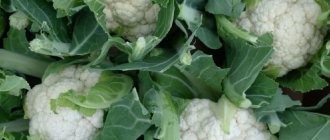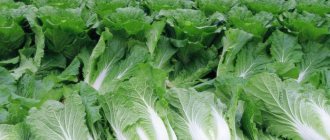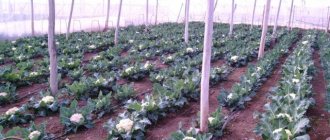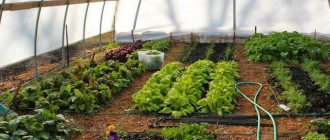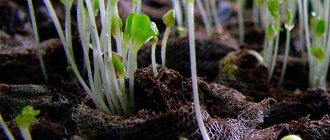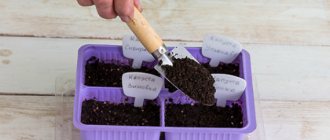In the old days, it was impossible to imagine a peasant’s garden without cabbage. So today, even on two hundred square meters, a couple of heads of this healthy and tasty vegetable will definitely grow. But in modern greenhouses today they grow not only white cabbage, but also equally healthy Beijing cabbage, Chinese cabbage, cauliflower, Savoy cabbage, Brussels sprouts, and even broccoli. And all because, although cabbage itself is a cold-resistant plant, it can still be destroyed by long-term low temperatures. That is why only a greenhouse can guarantee a good harvest. And cabbage cannot do without increased moisture, especially its seeds. But an excess, of course, can lead to the death of the roots. Therefore, in growing this particular vegetable, everything is good in moderation, and this measure is easiest to control in closed ground.
In the greenhouse there are simply ideal conditions for moisture-loving cabbage. That is why even a novice summer resident can grow more than a dozen birds in it per season. The main thing is to correctly calculate the timing of planting seeds, and growing cabbage in a greenhouse will be an easy and enjoyable experience.
Optimal timing
Typically, the timing of sowing seeds depends on what variety of cabbage is used.
- So early white cabbage is planted on March 10-15. Sowing in open ground occurs from early April to mid-June.
- Broccoli cabbage is sown in late March - early April. Planted from early May to mid-June. Kohlrabi and Chinese kohlrabi are planted in the same way.
- Cauliflower is sown from the beginning of April in 3 steps. Planting occurs in late May - early June.
- Late varieties are sown for seedlings at the end of April, and planted in open ground by the 3rd decade of June.
But all sowing and planting dates are conditional, since everything depends on the region, climatic and weather conditions.
It is worth noting that, regardless of the variety, seedlings should be planted in open ground under covering material.
Features of care
Agricultural technology for greenhouse cultivation of white cabbage is based on compliance with a number of conditions and implementation of the following recommendations.
- Light-loving vegetable crops, including white cabbage, prefer to be grown on southern and southeastern slopes.
- The optimal pH acidity of greenhouse soil should be from 6.7 to 7.4.
When cultivating cabbage in protected soil conditions, it is necessary to use the seedling method
- Cabbage is responsive to watering. Planting seedlings of white cabbage involves irrigation every two days at a rate of at least eight liters of water per square meter. At further stages of growth and development, the plants are watered once a week at the rate of twelve liters for each square meter of greenhouse area. Particular attention should be paid to watering in June for early varieties and in August for late varieties. Each watering should be accompanied by loosening the soil.
- Greenhouse beds for cabbage must be prepared in the fall. For this purpose, liming of the soil is carried out. Spring preparation for planting involves adding a bucket of organic matter with the addition of superphosphate, wood ash and urea for each square meter of greenhouse area.
- At the phase of formation of a pair of true leaves, the first foliar feeding of seedlings should be performed. For this purpose, it is necessary to dilute microelements and complex fertilizers into the water, which are used to thoroughly spray the seedlings.
- The second foliar feeding is performed during hardening of the seedling material. All seedlings must be sprayed with a solution containing potassium sulfate and urea.
Equally important when caring for this vegetable crop should be given to microclimatic conditions. Cabbage is demanding on lighting and humidity inside the greenhouse. Any changes in these parameters can negatively affect the growth of the vegetable crop and significantly reduce the quality and yield of heads of cabbage.
You can also learn how to grow cauliflower in greenhouse conditions by reading the corresponding article on our resource.
The standard distance between planted cabbage seedlings should be at least thirty centimeters
Preparation
Before sowing, you must carefully select the container in which it will be grown. Many people use peat pots, which can be purchased at any garden store.
Experts do not recommend using them, as they take away all the moisture and do not allow the plant to develop normally.
At the very beginning, it is recommended to use a regular plastic box, and then start diving after sunrise. What to do:
The soil needs to be prepared. To do this, you need to take any soil, sand, humus or peat, and wood ash. Add everything in approximately equal proportions and mix thoroughly.
The resulting mixture must be filtered and steamed in a double boiler or using a saucepan for 60 minutes. Loosening agents can be added to the finished mixture, which will provide a greater flow of oxygen to the root system.
Even before planting the seed, you can water the soil with a weak solution of potassium permanganate.
Seeds require careful preparation. To do this, place the seed in gauze or a bandage, pour it well with a solution of potassium permanganate, and leave for 20 minutes. Afterwards, rinse the seeds thoroughly.
Seed treatment with antifungal agents is required to prevent further disease of the adult plant.
After all the procedures, the seeds must be dried well and after time they can be planted in the ground.
Picks and secrets of growing strong seedlings
When plants develop 1-2 leaves, they can be picked or planted. The soil can remain the same, but it is better to slightly change the composition in accordance with the recommendations:
- 3 parts peat;
- 1 hour humus;
- 20 g per 10 liters of potassium sulfate and ammonium nitrate substrate and twice as much for superphosphate.
Picking and transplanting cabbage can be done when 2-3 leaves appear
In the absence of peat or, if desired, ordinary garden soil is taken according to a similar principle, but then more humus will be required - 3 parts.
Replanting should be done carefully, without disturbing the roots. After the procedure, it is recommended to shade the crops and increase the temperature by a couple of degrees for 2 days.
Advice. Plants should be thoroughly watered a couple of hours before the procedure. After transplantation, repeat.
Watering the crop occurs according to the following scheme: rarely, but abundantly. Optimally once every 10 days. It is important to control humidity. To balance it, it is necessary to ventilate the greenhouse. It’s better to add water in the morning.
Cabbage seedlings in a greenhouse
After 3 leaves appear on the bushes, it is time for primary feeding. Mineral fertilizers or a solution of liquid droppings or mullein - the choice is up to the summer resident. The second feeding occurs after 14 days with a slightly increased dosage. For example, they recommend:
- ammonium nitrate: I – 20 g, II – 30 g;
- potassium sulfate: I – 10 g, II – 20 g;
- superphosphate: I – 40 g, II – 60 g.
Cabbage in a mini-greenhouse
Landing
The soil must be well watered, the seed must be sprinkled on top and the soil must be covered on top. It is not recommended to sow too many seeds per 1 centimeter of soil, as cabbage does not like this. After this, you can pour a spray bottle on top to give even more moisture. At the end of planting, the box must be covered with film and placed in a warm place.
It is optimal to grow seedlings on the balcony, as there are the most comfortable growing conditions. If such conditions cannot be created, then you will have to grow cabbage in a warm room.
Expert opinion
Panina Lyudmila Alexandrovna
Gardener with extensive experience
I recommend maintaining the temperature at 15-18 degrees during the day, and reducing it to 8 degrees at night. Such procedures are done to strengthen the plant and get used to temperature conditions.
When the first 2-3 leaves appear, it is necessary to pick, that is, transplant into separate containers or pots. This is done to improve lighting, increase nutrition of the root system and strengthen the plant before planting. Pots are chosen 6 by 8 cm in size. The same mixture is poured into them as for the initial planting, you can add saltpeter or potassium chloride.
Option #2 – Chinese cabbage
Tasty and beautiful Chinese cabbage is early ripening. It is most convenient to grow it in seedlings. Peking cabbage primarily requires high humidity - 70-80%.
Also, in order to successfully grow Chinese cabbage in a greenhouse, it is important to maintain optimal temperature conditions. After all, this cabbage is a cold-resistant plant, and exceeding the temperature in the greenhouse by more than +15-20°C will immediately lead to the formation of a flowering stem. And in general, a violation of the temperature regime is fraught with plant disease, which is why the pot may simply not form.
Possible mistakes
So, what mistakes can be made when growing cabbage:
Dense sowing of seeds in a container.
As noted earlier, cabbage does not like little space, and therefore it is impossible to grow strong seedlings with such sowing. Most likely, such seedlings will die when planted in open ground. Too little light. Cabbage is a very heat-loving plant, so lack of heat and light will make it impossible to grow healthy seedlings. In most cases, seedlings grow small and weak.
Lack of watering and spraying.
Any seedling requires a lot of moisture for normal development; cabbage especially loves moisture, so it is necessary to carefully monitor the water level of the soil. But you shouldn’t overdo it, because if there is too much moisture, the root system will not feel comfortable and may even rot and die.
There is no temperature difference.
As mentioned earlier, this procedure will help strengthen the root system and the plant as a whole. If this is not done, the cabbage may die when planted in open ground, especially if the weather is cool outside. Experienced summer residents recommend taking the seedlings out into the hallway or onto the balcony so that they get used to the weather conditions.
Growing healthy and strong seedlings is easy if you follow the basic requirements: enough light, space, heat and moisture.
You should study the selected variety in advance and plant the seeds at the optimal time for it. Beginners often make mistakes when growing cabbage:
- planting too many seeds;
- do not monitor daylight hours;
- amount of liquid;
- ambient temperature.
All this leads to a decrease in the amount of harvest.
Grow, “garden head”: how to grow cabbage wisely
Crispy cabbage has firmly established itself in our diet for a reason, because among the widest variety of garden crops, this low-calorie product is a real storehouse of vitamins and microelements. It has been known since time immemorial, and received its name from the ancient Roman word “caputum”, meaning “head”. And in Rus' this vegetable had a figurative nickname - “garden head”. Today it is difficult to meet a gardener who does not grow cabbage - white heads can be seen behind almost every country fence. Growing this beauty so that the forks are dense and the leaves are juicy and crisp is actually not difficult if you know some rules.
FAQ
Is it possible to do without picking?
You can do without picking, initially plant each seed in a separate pot
What to choose for cabbage: purchased soil or a mixture of regular soil and humus?
Since store soil contains the optimal amount of minerals and organic matter, it is best to use it.
Is it possible to do without fertilizing the container with seedlings?
Yes, but in this case you should thoroughly fertilize the soil before planting the seedlings in the garden.
Is it possible to store seedlings on a windowsill?
The battery under the windowsill heats up the container greatly, which leads to a decrease in the germination percentage, so it is best to use a special rack.
Do I need to add light to the seedlings?
Depends on the timing of planting - cabbage should have at least 10 hours of daylight.
Option #1 – early cabbage
The most important thing is to choose the right variety of early cabbage. So, some of the most well-proven ones include:
- "Ditmar's early" This is an early ripening variety, which will produce the first harvest 50-70 days after planting the seedlings in the greenhouse.
- "Golden hectare 1432". For this variety, the period from planting seedlings to the first heads of cabbage is 105-129 days. This variety is distinguished by the resistance of heads of cabbage to cracking, which in itself is important.
- “Number one K-206.” If you use this variety, then from the appearance of the first shoots to the heads of cabbage it will take approximately 100-125 days. But all heads of cabbage will ripen together, giving from 25 to 40 kg of harvest for every 10 m2. It is only important to remove everything in time - otherwise the heads of cabbage will have time to crack.
There are no special tricks for growing such cabbage, so we move on.
Pest prevention
Cabbage seedlings can be prevented from developing by at least 6 different pests: cruciferous flea beetles, cabbage flies, cabbage moths, cabbage whites, cabbage cutworms and cabbage aphids. To avoid their appearance on seedlings, cabbage should be sprayed with Inta-Vir or Fitoverm biological products in a tank mixture.
- How to treat cabbage against pests
Cabbage is a common crop, but also very vulnerable to pests. How to protect it in the early stages of growth?
Choosing the right variety
The ripening period of the crop and its purpose largely depend on the choice of cabbage variety. White cabbage comes in early, medium and late varieties. Early varieties of cabbage are suitable for fresh consumption: they are tender and juicy, but cannot be stored for long. Mid-ripening heads of cabbage can be used fresh, and they are also suitable for short-term pickling. Late varieties are best suited for winter storage. They will also appeal to those who want to ferment cabbage for a long time.
How to prepare the soil?
– this is sandy loam. It will be better if your greenhouses are located on a small hill (if there is one on the site): in this case, the soil will dry out much faster in the spring, which means that the start of the planting process can be noticeably accelerated.
It is better to start cultivating the planting soil in advance - in the fall, this is done so that the pests living in the soil die during frosts, leaving you with clean and fertile soil suitable for vegetables.
It is better to plant cabbage in the part of the garden where onions, legumes, carrots, cucumbers or potatoes used to grow, because these vegetables leave behind nutrient-rich soil.
. In addition, cabbage does not grow well in former beds of radishes, radishes, lettuce or any other cruciferous vegetables. .
It is advisable to remove all vegetation from the garden immediately after you have harvested the autumn harvest. After this, carefully dig the soil as deeply as possible, while simultaneously fertilizing the soil. Both organic fertilizers, such as compost or manure, and minerals will help.
Further soil preparation should be carried out in March, before planting. If the ground becomes hard, it is necessary to dig it up again. .

